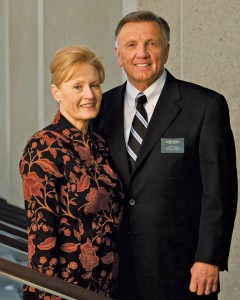Not all missionaries are young. After retirement, many Mormons go on missions. They may have served missions when they were young, or they may not have. What unites them is the desire to serve, whether they’ve served in the “mission field” before or not. These late-life missionaries are called, as a group, senior missionaries.
 Like the more common and better-known young Mormon missionary, the senior missionary goes with a companion. Unlike the young missionary, however, the senior missionary’s companion is usually his spouse. Sometimes older women choose to serve with a female friend. (Young missionaries must be unmarried.) This doesn’t mean that the single, widowed, or divorced senior can’t serve a mission – merely that going as a married couple is most common.
Like the more common and better-known young Mormon missionary, the senior missionary goes with a companion. Unlike the young missionary, however, the senior missionary’s companion is usually his spouse. Sometimes older women choose to serve with a female friend. (Young missionaries must be unmarried.) This doesn’t mean that the single, widowed, or divorced senior can’t serve a mission – merely that going as a married couple is most common.
Senior missions tend to be more varied than the missions of younger missionaries. Although senior missionaries can fulfill proselyting missions (where, like younger missionaries, they preach the gospel to whomever will listen), they have a few other options. They can perform part-time, local missions, acting as volunteers for LDS Church humanitarian projects. Likewise, they may staff genealogy libraries or the visitors’ centers of Mormon temples.
They may, again, also go on full-time missions, including the proselyting missions associated with young missionaries, but there are other types of full time missions they can undertake, particularly if they have unique skills – such as medical expertise or expert knowledge of a foreign language. They may go on humanitarian missions. These missions can involve such essential tasks as medical assistance for a community, or helping that community acquire food and clean water. They may also serve leadership missions to train local members in how to be better LDS Church leaders, especially in areas where the Mormon Church is still very new.
Like young missionaries, senior missionaries will spend time at a Missionary Training Center. Also like young missionaries, they serve within a particular mission under a Mission President. However, they might also report to someone who oversees their particular field of labor. For example, a senior couple serving a humanitarian mission will also work with the Mormon Church’s large humanitarian program.
Senior Mormon missionaries share another similarity with the young ones – they must pay their own way. Many seniors save up for years to go. If financially unable to put together enough money to go, or physically unable to make a journey (and accomplish the mission afterward), the senior is encouraged to seek out more local opportunities for service. This much is common across all people and all cultures – service brings happiness and is pleasing to the Lord.
In fact, many senior missionaries who can go on a mission are so enthusiastic about the experience that they serve multiple missions, which the LDS Church allows them to do. Although separation from their children and grandchildren is difficult, and they make the most of family time in between missions, many Mormon couples serve more than one mission.
Senior missionaries are often allowed to choose what type of mission to go on and even where. They are always needed and always encouraged to go, to bring their years of expertise and faith into the mission field.
